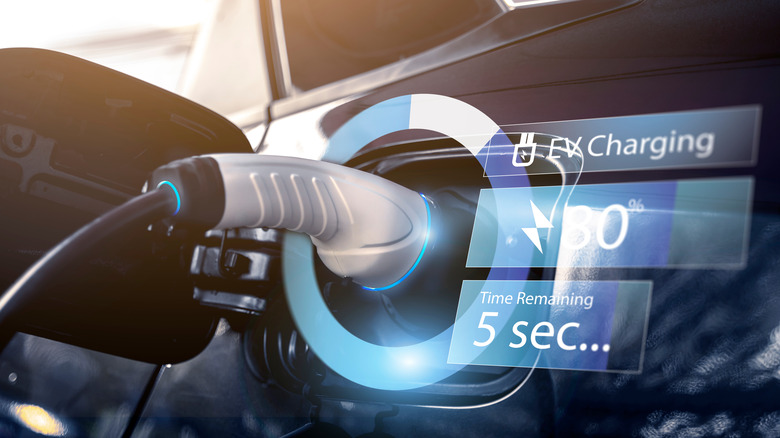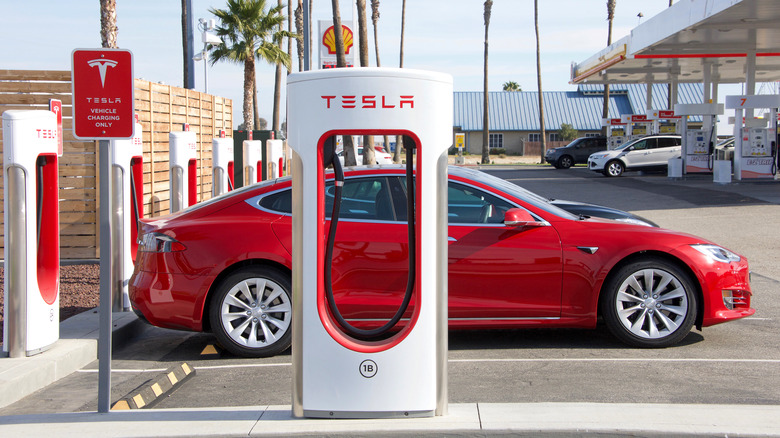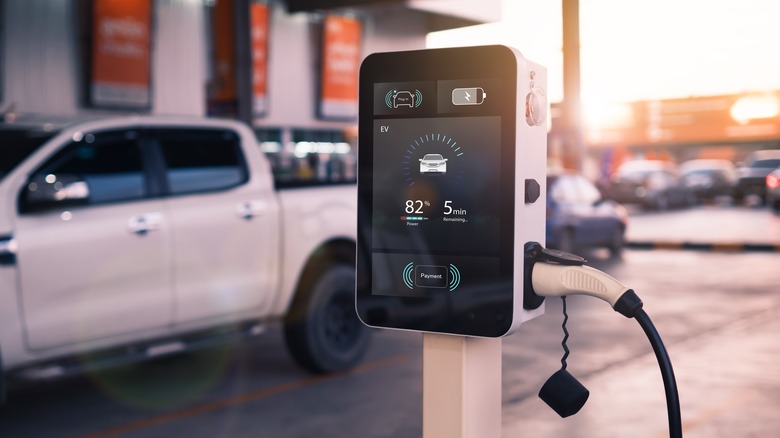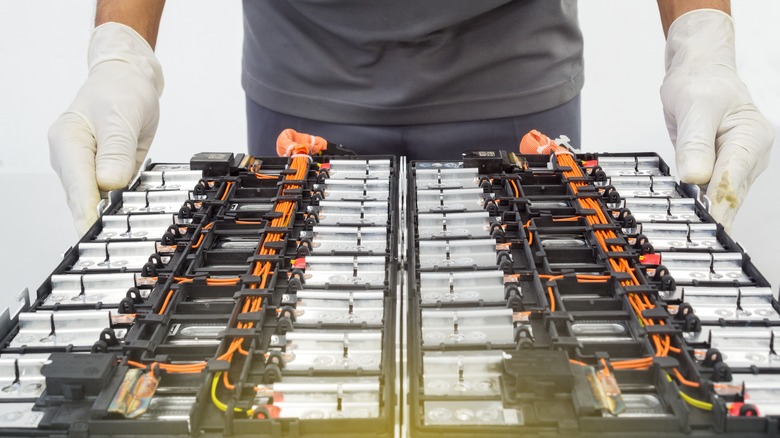This New EV Charging Method Can Take Just Minutes
Electric vehicles have come a long way. A few decades ago, they were impractical fringe models — something only driven by extreme enthusiasts and a few eco-warriors who didn't want to be too reliant on bicycles. Now, these vehicles are not only practical but pushing the limits of performance. Companies like Tesla have made EVs mainstream and people in the market for a daily driver aren't stuck with a selection of battery-powered compacts, either. You can currently get all-electric muscle cars, SUVs, and pickup trucks. Tesla even has an all-electric semi truck on its long list of vehicles that are due to be released soon.
An electric vehicle's range, which was once a major concern, can now top hundreds of miles on a single charge. In terms of performance, there are EVs that can go from 0 to 60 mph faster than some hypercars. Alongside transferring the motor's power to the road surface, the torque on offer also means EVs boast better handling than a lot of their conventional counterparts.
Despite the staggering progress, there is still one area skeptics love to point to. While some high-end EVs now have ranges of hundreds of miles, coming close to some of the more economical gas vehicles, there is still the matter of what to do when that range runs out. Filling a tank with gas takes a few minutes, while charging is a process that can take hours. However, progress has been made in this area too, and a recent development may have changed EV charging forever.
Things are already pretty fast
There are already some very fast charging options available. If you go home at night and plug your EV into an outlet in your garage, there's a good chance things will be pretty slow. Charging speeds boil down to the type of charger you're using. Level 1 chargers, which usually come with your car, plug into a standard 120-volt socket. These basic chargers can add as little as three miles of range per hour, so if you have an EV with a half decent range, filling the battery could take the best part of a week. Luckily, Level 1 chargers aren't the only option.
You can opt for a faster Level 2 charger that uses a 240-volt connection. This can either be a 240-volt outlet if you have one in the garage or a direct connection installed from the breaker box. A good Level 2 charger may set you back between $500 and $800, but if you're an EV owner, it's well worth the money. At the high end, you can get up to 30 miles of range per hour of charging.
Then there are public chargers, some of which are Level 3. At that rating, chargers use direct current and provide up to 350 kW of power. A Level 3 charger can provide over 100 miles of range in less than 20 minutes. At the pinnacle of public charging are Tesla's Supercharging Stations. The 250 kW V3 stations are capable of providing up to 1,000 miles of range in an hour. To put things into perspective, it takes the Tesla Supercharger less than 15 minutes to provide the same amount of juice as a Level 1 charger will put out in 200 hours.
Charging infrastructure is improving
While electric vehicles may be advancing rapidly, the infrastructure they need to be truly practical isn't quite there yet. Places with high uptake like California don't have enough chargers to go around. While other states like Wyoming have fewer charging stations in terms of raw numbers, they have far more per electric vehicle. Beyond charging port crowding is how all of the stations are spaced out across the country. Most major North American roads have gas stations at regular intervals, but you can't say the same about EV charging stations. There are fewer than 55,000 EV charging stations in the United States, which is roughly one-third the number of gas stations. Any long trip would have to be planned around recharging stops with backup plans in place in case chargers are out of order, but things are changing.
The Biden administration is hoping half a million EV charging ports will be available across the U.S. by the end of the decade. Billions of dollars are being set aside for various EV infrastructure projects, including the creation of what the Department of Transportation is calling alternative fuel corridors. So planning an EV road trip in a few years might be less of a headache; you'll just be able to pull up a map and follow the DOT's green lines to your destination. Beyond the government, private finance is also doing its bit to get the U.S. EV-ready. Companies including Tesla, Siemens, Volkswagen, Pilot, and Electrify America are all undertaking projects to help rapidly increase the number of charging points available to EV drivers.
A new charging method could speed things up further
Electric vehicle owners could soon be charging their battery to 90% in as little as 10 minutes. That could mean over 450 miles' worth of range from something like a Lucid Air in around the same amount of time it takes to fill a gas tank and pay the cashier. Researchers from the Idaho National Laboratory have used their knowledge of batteries, a machine learning program, and large amounts of data to optimize the charging process without damaging or destroying the battery in the process (via EurekAlert).
Idaho National Laboratory's Eric Dufek, Ph.D., who presented the project to a meeting of the American Chemical Society, explained, "Fast charging is the key to increasing consumer confidence and overall adoption of electric vehicles. It would allow vehicle charging to be very similar to filling up at a gas station."
There is a danger of damaging the battery while fast charging. Speeding up the charging process can lead to a build-up of lithium ions on the battery's cathode and lead to failure. However, researchers from Idaho National Laboratory believe they have found a way around this. It involves tailoring the charging process to the battery itself, a process that requires massive amounts of data about the batteries. A specially trained AI then uses that data to create a unique charging protocol for the battery.



